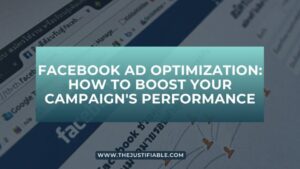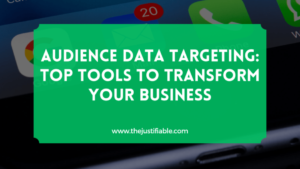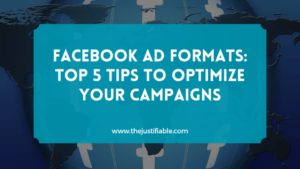How do you determine your app’s earning potential? Calculating ad revenue for an app is essential for developers and marketers to optimize profits and measure success. This guide provides step-by-step instructions to help you understand how to calculate ad revenue of an app effectively while addressing key factors to maximize your earnings.
1. Understand The Basics Of App Ad Revenue
Understanding how app ad revenue works is the first step to unlocking your app’s earning potential. This foundation allows you to make informed decisions about strategies and tools to maximize your revenue streams effectively.
Define Ad Revenue Models And How They Work
Ad revenue models are the backbone of app monetization, offering various ways to generate income. Whether you’re running banner ads, interstitials, or rewarded videos, these models dictate how advertisers pay you and how users interact with your ads.
One popular model is Cost Per Mille (CPM), where you earn a set amount for every thousand impressions. This approach works well if your app garners a high number of daily users. On the other hand, Cost Per Click (CPC) rewards you each time a user clicks an ad, focusing more on engagement than sheer visibility.
Cost Per Action (CPA) is another model where payments occur only when users complete a specific action, like signing up for a newsletter. This model can be lucrative but requires ads to match user intent closely. Subscription-based ad models, though less common, integrate ads into paid content streams, balancing user experience and earnings.
Choosing the right model depends on your app’s audience and purpose. For instance, a casual gaming app may thrive with rewarded video ads, while a utility app could perform better with unobtrusive banners.
Explore Key Metrics Like eCPM And Impressions
Metrics like eCPM (effective Cost Per Mille) and impressions are critical in understanding your app’s ad revenue. They help you measure performance and identify growth opportunities.
eCPM essentially calculates the revenue earned per thousand ad impressions. It’s a vital benchmark because it indicates how effectively your ad placements generate income. A higher eCPM means more revenue, even with fewer impressions, making it a critical focus for optimization.
Impressions, meanwhile, represent the number of times an ad is displayed. They’re a volume-based metric, giving you insight into how often users are exposed to ads within your app. High impressions are great, but they must pair with user engagement to truly drive revenue.
Combining these metrics provides a clearer picture of ad performance. For example, if your eCPM is low despite high impressions, it may indicate poorly optimized ad placements or irrelevant ad content.
Regularly tracking eCPM and impressions helps you spot trends, identify high-performing placements, and test new ad formats for better results.
Differentiate Between Ad Placement Types
Ad placements refer to where and how ads appear in your app, and this can drastically impact revenue. The right placement ensures ads enhance the user experience instead of disrupting it.
Interstitial ads are full-screen ads that display at natural pauses, such as between game levels. They’re highly engaging but should be used sparingly to avoid annoying users. Banner ads, on the other hand, occupy less space and can stay visible throughout app usage without interrupting user flow.
Rewarded ads are a favorite in gaming apps. Users voluntarily watch these ads to earn in-app perks like coins or extra lives. This model increases engagement while boosting ad revenue. For apps with heavy traffic, native ads seamlessly blend into the app’s design, maintaining user experience while providing value.
Choosing the right placement type depends on your app’s content and user habits. Testing different placements can help you find the sweet spot between user satisfaction and maximizing revenue.
Recognize Factors That Affect Revenue Potential
Several factors influence your app’s ad revenue, and recognizing them can help you strategize better.
The first is user demographics. An app targeting a high-income audience in premium regions (e.g., the US or Western Europe) will typically generate more ad revenue than one targeting regions with lower advertising budgets.
User engagement also plays a significant role. High session durations and repeat visits boost ad impressions, which directly translates into better earnings. The app category matters too—gaming apps, for example, often earn more due to higher ad engagement.
Another factor to watch is the quality of ad networks. Premium networks provide better payouts and more relevant ads, which enhances user experience and revenue alike. Lastly, keep an eye on ad frequency. Too many ads can frustrate users, while too few can leave revenue on the table.
By analyzing these factors, you can fine-tune your approach and maximize your app’s earning potential.
2. Choose The Right Advertising Platform For Your App

Finding the perfect advertising platform is key to monetizing your app effectively. The right platform ensures higher earnings, smooth integration, and tailored ad solutions that match your app’s audience and revenue goals.
Compare Popular Ad Networks And Their Benefits
Ad networks like Google AdMob, Unity Ads, and Facebook Audience Network dominate the market, each offering unique advantages. Choosing between them depends on your app’s target audience, ad format needs, and revenue expectations.
Google AdMob provides broad reach and seamless integration, making it a go-to for many developers. Its vast network ensures ads are relevant, helping improve click-through rates (CTR) and overall revenue. Facebook Audience Network, on the other hand, excels in delivering high eCPMs for apps with a socially engaged user base.
Unity Ads focuses on gaming apps, offering robust rewarded video formats. If your app fits the gaming niche, Unity’s ability to increase user engagement while boosting ad revenue is invaluable. Similarly, networks like IronSource specialize in innovative ad formats, helping developers monetize without overloading users with ads.
I suggest exploring network reviews, payout histories, and integration capabilities before settling on one. Testing multiple networks can also reveal which delivers the best results for your app.
Assess Payout Structures For Ad Networks
Not all ad networks follow the same payout rules, so understanding their structures is crucial. Look at factors like CPM rates, payment cycles, and thresholds before committing to a platform.
For instance, some networks provide high CPMs but may delay payments, which could impact cash flow. Google AdMob generally offers consistent payouts but may have stricter policies compared to smaller networks. Conversely, Unity Ads often provides quicker payouts, which is ideal for developers who need steady income.
Look into revenue-sharing models as well. Some networks retain a larger percentage of earnings, so it’s worth comparing net revenues across platforms. Low thresholds for payouts can also be helpful if you’re just starting.
I recommend contacting support teams for clarity on complex payout terms. A clear understanding of these structures ensures you optimize earnings without unexpected surprises.
Evaluate Compatibility With App Categories
Not all ad networks work equally well across every app category. Your app’s type, whether gaming, utility, or lifestyle, significantly influences which ad platform is best suited for it.
For gaming apps, networks like Unity Ads or IronSource are great because they focus on immersive ad experiences like rewarded videos. For lifestyle or shopping apps, Facebook Audience Network excels in delivering personalized ads that engage users effectively.
Utility apps, which often see lower session durations, may perform better with networks that specialize in non-intrusive banners or interstitials. Google AdMob offers flexibility here, letting you experiment with multiple formats to see what works best.
I suggest testing platforms on a small scale to ensure they align with your app’s audience and usage patterns. Tailoring the network choice to your app’s niche maximizes both ad revenue and user satisfaction.
Identify Tools For Monitoring And Reporting
To optimize ad revenue, having the right tools for monitoring is a must. Most major ad platforms offer built-in analytics, but combining them with third-party tools provides deeper insights.
Platforms like AdMob come equipped with dashboards to track metrics like impressions, eCPM, and CTR. If you’re using Unity Ads, you can dive into data on rewarded ad completions and engagement rates. While these tools are handy, pairing them with third-party platforms like Adjust or App Annie gives a holistic view of performance.
I advise setting up automated reports to track trends effortlessly. These reports highlight patterns, allowing you to tweak ad placements or formats proactively. It’s also worth experimenting with A/B testing to see which strategies drive better results.
3. Collect The Necessary Data For Accurate Calculations

Accurate data collection is the foundation of calculating your app’s ad revenue. Without the right numbers, it’s impossible to measure performance or make strategic decisions that enhance your earnings.
Track Key Metrics Like Click-Through Rates (CTR)
CTR is a critical metric that reflects how often users click on your ads relative to the number of impressions. Monitoring this helps you gauge how engaging your ads are to your audience.
For example, if your CTR is consistently low, it may indicate poorly placed ads or irrelevant content. Adjusting your ad formats, like switching from banners to rewarded videos, can lead to higher user interaction. I suggest testing different ad placements or updating creatives to improve these metrics.
Tracking CTR over time also reveals seasonal trends, such as increased clicks during holiday periods. Recognizing these patterns helps you capitalize on peak seasons, boosting both CTR and revenue.
Ensure you’re analyzing CTR data for different user segments. Segmenting by region or demographics provides actionable insights into which groups respond best to specific ad types.
Record Daily Ad Impressions And Fill Rates
Daily ad impressions and fill rates are essential for understanding the volume and consistency of your ads. Impressions track how often users see ads, while fill rates show what percentage of available ad slots are successfully filled.
High impressions with low fill rates often indicate an issue with your ad network or settings. Increasing the number of ad sources or optimizing your placements can resolve this. I suggest monitoring fill rates daily to avoid missed revenue opportunities.
Low impressions could point to reduced app traffic or session times. Encouraging users to spend more time on your app with engaging content or features can lead to higher ad exposure.
Keeping a consistent log of impressions and fill rates helps you identify bottlenecks and fine-tune your monetization strategy for maximum returns.
Use Analytics Tools To Gather Revenue Insights
Analytics tools are the backbone of effective ad revenue calculations. They offer granular details that help you measure and optimize every aspect of your monetization strategy.
Platforms like Google Analytics or Firebase provide deep insights into user behavior, ad performance, and app engagement. Use these tools to identify top-performing ad formats and pinpoint areas needing improvement.
Many analytics tools also allow you to compare revenue trends across different timeframes. For example, you can track daily, weekly, or monthly revenues to determine which strategies yield the best results. I recommend setting clear KPIs and regularly revisiting your analytics dashboard to ensure you’re on track.
These tools simplify data interpretation, letting you focus on actionable improvements rather than being bogged down in numbers.
Monitor Regional And Demographic Data Trends
Demographics and regions significantly influence ad revenue, as different audiences have varying ad preferences and eCPM values. Monitoring this data ensures you tailor ads to suit your audience.
For instance, users in North America and Western Europe often yield higher eCPMs compared to other regions. If your app’s user base is concentrated in these regions, optimizing for ad formats that perform well there is crucial.
Tracking demographics also helps you choose relevant ad creatives. Ads that resonate with specific age groups, gender, or interests perform better, leading to higher CTRs and revenues.
I suggest diving into your app analytics to cross-reference demographic data with ad performance. This alignment helps refine targeting strategies and improve ad relevance for your audience.
4. Apply A Formula To Calculate App Ad Revenue
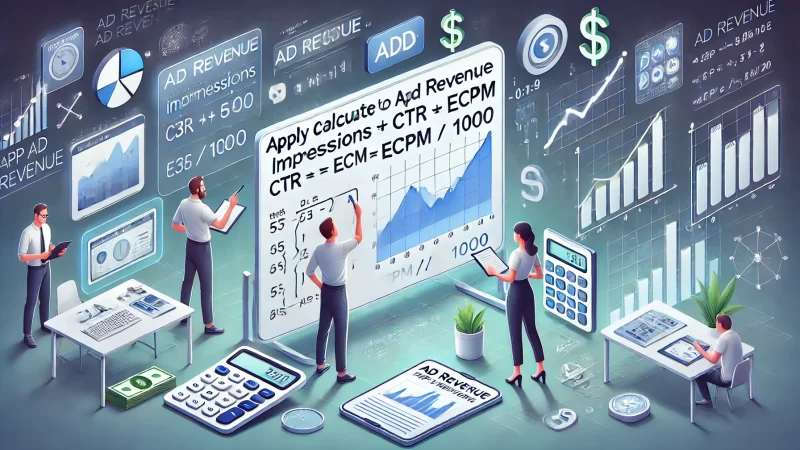
Using a clear formula is essential to calculate app ad revenue accurately. It allows you to gauge your app’s earning potential based on key metrics like impressions, engagement, and ad performance, helping you make data-driven decisions.
Use The eCPM Formula For Revenue Estimation
The eCPM formula is a straightforward way to estimate your app’s ad revenue. It calculates the earnings per thousand impressions and is widely used to track ad performance and revenue potential.
To calculate eCPM, use the formula:
eCPM = (Total Earnings ÷ Total Impressions) × 1,000
For instance, if you earned $100 from 50,000 impressions, your eCPM would be $2. Tracking this value regularly helps you identify trends and make informed decisions about ad placements.
I suggest focusing on ad networks that offer high eCPMs, as they indicate better-paying ads. A low eCPM might mean ads aren’t engaging users effectively, signaling a need for optimization or a different ad network.
Remember, while eCPM is valuable, it works best alongside other metrics like CTR and fill rates. Together, they give a more comprehensive view of how your ads contribute to revenue.
Incorporate User Engagement Metrics Into Calculations
User engagement metrics, like click-through rates (CTR) and session duration, are crucial for understanding how users interact with ads. These metrics directly influence your app’s overall ad revenue.
CTR measures how often users click on ads after seeing them. A higher CTR means your ads are relevant and engaging. For instance, a CTR of 5% from 1,000 impressions means 50 clicks, contributing significantly to revenue.
Session duration and repeat visits also impact ad revenue. Longer sessions lead to more ad impressions, while repeat visits increase total engagement over time. Tracking these metrics helps you refine your app design to enhance user retention.
I advise combining engagement data with eCPM to see the full picture. High engagement often leads to higher eCPM values, as advertisers value apps with active, responsive users.
Calculate Revenue Based On Ad Types And Placements
Different ad types and placements yield different results, so understanding their impact is key to precise revenue calculations. Each format, from banners to rewarded videos, has unique performance metrics that influence your app’s earnings.
Banner ads are simple and ideal for consistent but low-level revenue. On the other hand, interstitial and rewarded video ads typically offer higher payouts due to their immersive nature. For example, rewarded videos often have completion rates exceeding 75%, making them a lucrative option for gaming apps.
The placement of ads also matters. Ads shown at natural pauses, like between game levels, perform better than those interrupting user activity. I suggest experimenting with placements to discover what drives the most revenue without harming user experience.
Regularly reviewing revenue from each ad type and placement ensures you’re maximizing your earnings potential while keeping your app’s user base satisfied.
Adjust For Real-Time Variability In Ad Performance
Ad performance isn’t static, and factors like seasonality and user behavior can impact revenue. Adjusting for these real-time changes ensures your calculations remain accurate and actionable.
For example, ads tend to perform better during holiday seasons when advertisers increase budgets. Monitoring these trends lets you anticipate spikes in eCPM and impressions, helping you capitalize on high-demand periods.
I recommend using real-time dashboards provided by ad networks to stay updated. These tools track fluctuations in CTR, eCPM, and fill rates, allowing you to adapt quickly. For instance, if a specific ad format suddenly underperforms, you can replace it with better-performing options.
By staying agile, you can respond to performance changes and maximize your app’s ad revenue consistently.
5. Optimize Ad Revenue With Strategic Insights
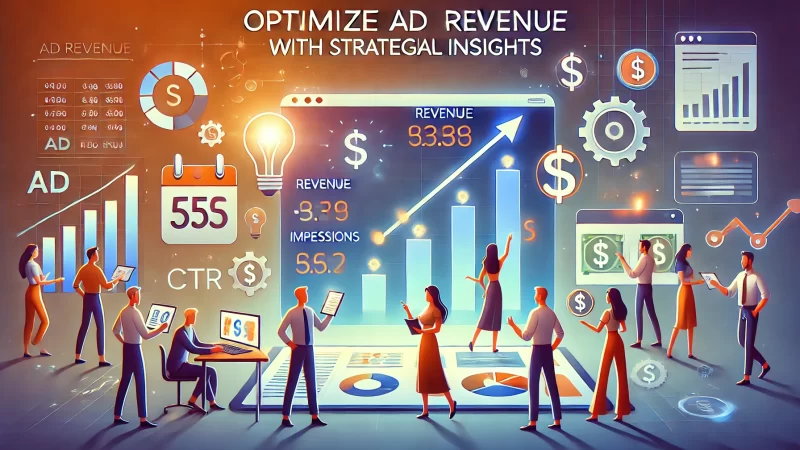
Strategic insights can help you go beyond basic ad revenue calculations. Implementing smart practices, like testing ad formats and monitoring trends, ensures sustained growth in earnings while maintaining a great user experience.
Increase Ad Frequency Without Hurting User Experience
Finding the right ad frequency is a balancing act. Too many ads can frustrate users, while too few leave revenue on the table. The key is striking a balance that maximizes impressions without impacting user satisfaction.
For example, interstitial ads can be shown after every two or three levels in a game app. This keeps the experience smooth while ensuring regular ad impressions. Rewarded videos are another great option, as users opt into watching them voluntarily, increasing engagement.
I suggest gathering feedback from users to fine-tune your ad frequency. Monitoring session times and retention rates helps you determine whether your current approach works or needs adjustment.
Testing different frequencies across user segments also provides valuable insights. For instance, heavy users might tolerate more frequent ads than casual users.
A/B Test Different Ad Formats And Placements
A/B testing is one of the most effective ways to optimize ad performance. It involves comparing two versions of an ad format or placement to see which delivers better results.
For instance, you could test banner ads at the top of the screen versus the bottom. Similarly, compare rewarded videos with interstitial ads to see which yields higher engagement and revenue.
I recommend running these tests over a set period, ensuring you gather enough data to make informed decisions. Metrics like CTR, fill rates, and eCPM are great indicators of success during A/B testing.
Frequent testing ensures your ad strategy evolves alongside user preferences, keeping your app’s monetization efforts competitive and effective.
Utilize In-App Purchases To Supplement Revenue
Combining ads with in-app purchases can diversify your revenue streams and reduce overreliance on ads. This approach works well for apps with engaged users willing to spend on premium content.
For example, offer an ad-free experience as a paid option. Users who dislike ads may gladly pay for uninterrupted usage. Alternatively, use rewarded ads to incentivize purchases, such as offering bonus coins for watching ads.
I suggest analyzing user behavior to see where in-app purchases fit naturally. If your app is a game, premium skins or extra lives could complement your ad strategy.
Balancing in-app purchases with ads ensures you maximize earnings while giving users flexible monetization choices.
Analyze Trends To Scale Revenue Streams Effectively
Tracking trends is crucial for scaling your ad revenue strategy. Seasonal peaks, demographic shifts, and ad format innovations all play a role in shaping your app’s earnings potential.
For example, during holidays, advertisers often increase budgets, which boosts eCPMs. Preparing for these periods with optimized ad placements can significantly raise revenue. Similarly, staying updated on new ad formats ensures your app remains competitive in an evolving market.
I suggest using analytics tools to track performance metrics over time. Look for patterns, such as which regions or user segments generate the most revenue, and adjust your strategy accordingly.
By analyzing trends, you can fine-tune your approach and ensure your app continues to grow its ad revenue effectively.



